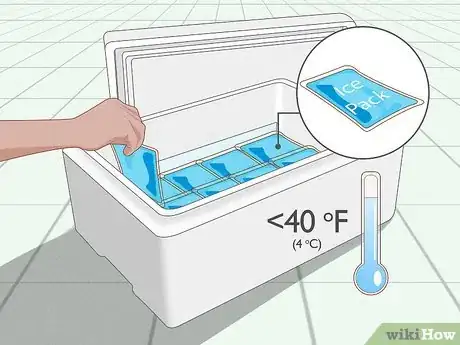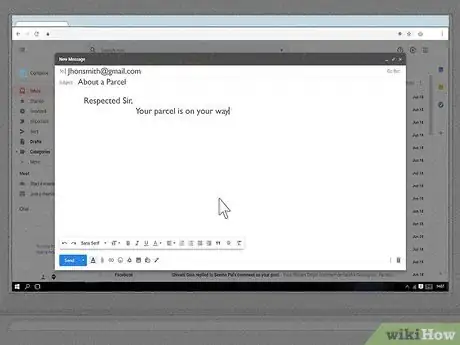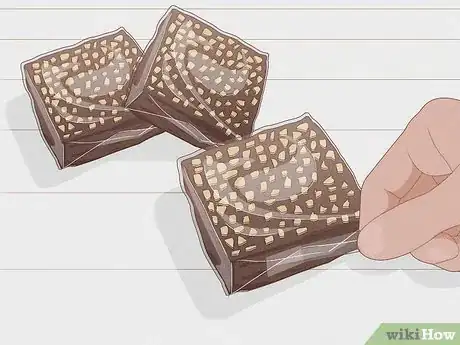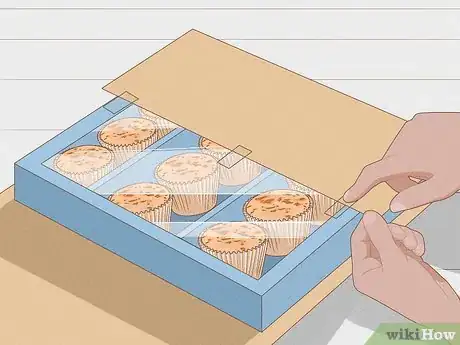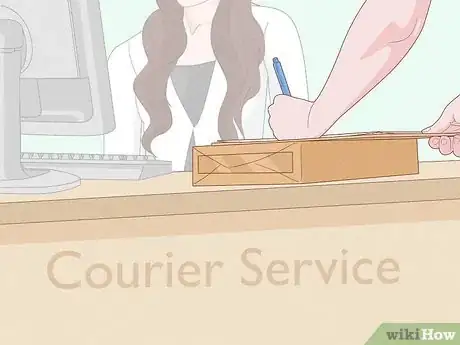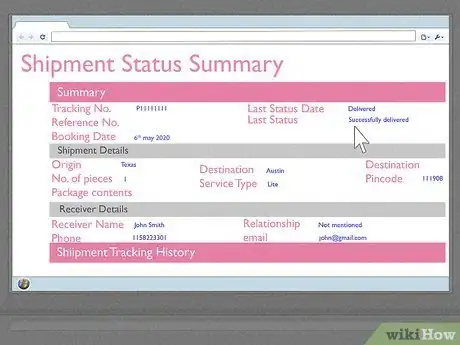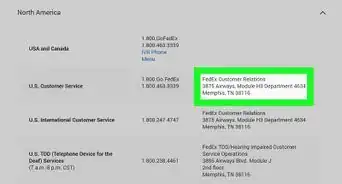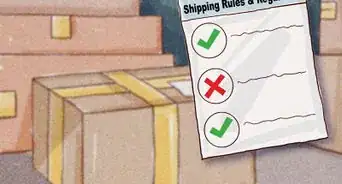This article was co-authored by Bill Holdenstern and by wikiHow staff writer, Janice Tieperman. Bill Holdenstern is a Baker and the Co-Owner of East Bay Pie Co. in San Francisco, California. With over 10 years of experience in the food industry, he specializes in making pot pies filled with flavors from around the world. Bill trained with chefs in multiple restaurants and studied business at Bunker Hill Community College. East Bay Pie Co has been profiled in The Manual, Purple List, and Nosh.
This article has been viewed 222,205 times.
Shipping food can be tricky, especially if you’re sending something perishable, like refrigerated foods or baked goods. It’s important to ship these foods out as quickly and efficiently as possible, or else they can start collecting bacteria.[1] While it may cost a bit of extra money, you only need a few simple packaging supplies to mail your food as quickly as possible.
Steps
Packaging Cold Foods
-
1Select a large cardboard box that will fit your food. Estimate how much space your frozen or refrigerated food will take up. If you’re preparing a large shipment, you’ll need a large cardboard box to serve as the base for your package. If you’re sending something smaller, like a mini container of ice cream, you may be able to use a smaller shipping box.[2]
- You can find cardboard boxes at most stores that sell mailing supplies. If you’d like to save on shipping costs, visit your local post office to see if you can use any specially priced boxes.
-
2Choose a sturdy styrofoam container that will insulate your cold food. Look for a styrofoam carton that fits snugly inside of your cardboard box, and is at least 1 1⁄2 in (3.8 cm) thick. Check that there’s enough room in the carton for your refrigerated or frozen goods, along with space for your gel packs or dry ice.[3]
- Some companies sell insulated shipping boxes, which come with both a cardboard box and a styrofoam carton.
- Instead of styrofoam, you may use some kind of recyclable foam material, but it still needs to be at least one inch thick.
Advertisement -
3Bag your food with plastic if it may melt or leak. Think about the type of food you’re sending—if it’s likely to melt over time during shipment, place the food in 2 secure plastic bags. Squeeze out any extra air from the first bag so it's airtight. Twist the top of the bag into a coil and fold it downwards, then secure it place with a rubber band. Repeat this process with a second bag so your food is completely secure.[4]
- Any plastic bag works well for this.
- If you’re shipping something extra fresh, like seafood, consider placing absorbent pads along the bottom of your container. This can protect your box from turning soggy.
-
4Place a liner bag in the center of the styrofoam carton. Purchase a large, rectangular plastic bag that “lines” the styrofoam layer of the box, which protects the package from leaks. Secure this into the box first so you can place your refrigerated or frozen food securely inside.[5]
- You can find liner bags online, or at a store selling mailing supplies.
-
5Add gel packs or dry ice so the food stays under 40 °F (4 °C). Layer dry ice packs around your container of chilled food. Always use gloves when handling dry ice or other cold packs so you don’t get frostbite. Place another cold pack on top of the food. The cold always goes down, so this way the food will stay completely chilled in transit.[6]
- You can purchase cold packs from any specialty store selling mailing supplies.
- Plan your ice amount and packaging according to the expected delivery time, adding one extra day. For example, if the shipping company tells you they would deliver it within one day, plan for two days.
-
6Seal the package and wrap it with 2 layers of packing paper. Place a lid over the styrofoam carton and tape the cardboard box shut. As an extra precaution, wrap the entire box with 2 layers of brown mailing paper.[7]
-
7Write the recipient and your contact info on the box. Address the package to your desired recipient, and include your own name and return address on the package. Leave your phone number as well as the recipient’s on the box, so a postal service worker can call one of you if something goes wrong with the package.[8]
Tip: Write “Keep Refrigerated” or “Perishable” on the mailing label so post office workers and your recipient know what’s inside the package.[9]
-
8Tell the recipient to expect a package. Call, text, or email the person to let them know to expect a special delivery in a day or two. Remind them to open it and store the food right away, or else it may go bad.[10]
Sending Baked Goods
-
1Ship baked goods that aren’t as likely to crumble. Choose a sturdy recipe that can take a potential beating in the mail, like cookies, unfrosted cupcakes, or brownies. Use caution when shipping anything really thin or delicate, as well as any desserts that need refrigeration.[11]
- For instance, it’s better to mail an apple pie than a lemon meringue pie.
-
2Support your food to keep it from crumbling. Wrap your food with foil or plastic wrap to keep it as fresh as possible. If you’re shipping brownies or bars, secure a sheet of wax paper between each tier so the baked goods don’t stick together.[12]
- Keep in mind that your package may tumble around during the shipping, and the only thing you can do is to pack it as well as possible.
-
3Store your food in an airtight container or package. Place your dessert in a secure box or container. Check that all the air is pushed out of the container so your baked goods don’t go stale in transit.[13]
- Reusable plastic containers can work for this, or a box or tin.
Tip: If there’s a lot of extra space in the box, place packing peanuts or bubble wrap around the food containers to provide padding.
-
4Seal and label the package as you normally would. Close off the package with packing tape, then add a mailing label to the top of the box. Write out your return address as well as the recipient’s address so the post office knows where the package needs to go. As an extra precaution, write “Perishable” on the side of the box so the postal service employees and your recipient know that something delicate is inside.[14]
Choosing a Delivery Time
-
1Send out your food early in the week so it ships quickly. Try to ship your food on Monday or Tuesday, so the box doesn’t get stuck in a post office over the weekend. Avoid sending your shipment on Friday or Saturday, or your food may end up spoiling.[15]
-
2Aim for your package to arrive at its destination within 30 hours. Select the fastest mailing option your post office provides so your food gets to the recipient ASAP. Keep in mind that this may be a bit pricey, but it’s a necessity when shipping perishable foods, especially refrigerated or frozen ones.[16]
- Frozen or refrigerated food needs to stay under 40 °F (4 °C). If it thaws out too much, it’ll start to spoil.
-
3Add a tracking number to your package so you can keep track of it. Ask a post office employee if they can give you a tracking number for the package. Input this number on the post office’s website to monitor where your package is, so you can make sure it reaches its destination within 30 hours.
Community Q&A
-
QuestionHow long will the food keep cold when packaged properly?
 Community AnswerIt will keep cool for days.
Community AnswerIt will keep cool for days. -
QuestionWhat is best way to ensure food will remain fresh?
 DonaganTop AnswererSeal it in an airtight bag.
DonaganTop AnswererSeal it in an airtight bag. -
QuestionCan send my son homemade stew overnight?
 Community AnswerIt depends on how far away you live from your son, how much you are willing to pay for shipping, the volume of the stew, and whether you have an airtight container that you trust will not leak. It certainly is possible, but there may be hindrances you will want to consider.
Community AnswerIt depends on how far away you live from your son, how much you are willing to pay for shipping, the volume of the stew, and whether you have an airtight container that you trust will not leak. It certainly is possible, but there may be hindrances you will want to consider.
Warning
- Cold shipping can get a bit pricey depending on the supplies that you use. If you can, deliver the food in person.
Things You’ll Need
Packaging Cold Foods
- Cardboard box
- Styrofoam carton
- Gel packs or dry ice
- Plastic bags
- Brown mailing paper
- Mailing label
- Marker
- Absorbent pads (optional)
Sending Baked Goods
- Cardboard box
- Airtight container
- Aluminum foil
- Plastic wrap
- Wax paper
References
- ↑ https://s3.wp.wsu.edu/uploads/sites/2071/2013/12/Mail_Order_Food_Safety.pdf
- ↑ https://www.fsis.usda.gov/food-safety/safe-food-handling-and-preparation/food-safety-basics/mail-order-food-safety
- ↑ https://www.fedex.com/content/dam/fedex/us-united-states/services/Perishables_fxcom.pdf
- ↑ https://www.fedex.com/content/dam/fedex/us-united-states/services/Perishables_fxcom.pdf
- ↑ https://www.fedex.com/content/dam/fedex/us-united-states/services/Perishables_fxcom.pdf
- ↑ https://s3.wp.wsu.edu/uploads/sites/2071/2013/12/Mail_Order_Food_Safety.pdf
- ↑ https://www.fsis.usda.gov/food-safety/safe-food-handling-and-preparation/food-safety-basics/mail-order-food-safety
- ↑ https://www.fedex.com/content/dam/fedex/us-united-states/services/Perishables_fxcom.pdf
- ↑ https://www.fsis.usda.gov/food-safety/safe-food-handling-and-preparation/food-safety-basics/mail-order-food-safety
- ↑ https://s3.wp.wsu.edu/uploads/sites/2071/2013/12/Mail_Order_Food_Safety.pdf
- ↑ https://www.myrecipes.com/how-to/how-to-ship-baked-goods-through-the-mail
- ↑ https://www.myrecipes.com/how-to/how-to-ship-baked-goods-through-the-mail
- ↑ https://www.ups.com/us/en/support/shipping-support/shipping-special-care-regulated-items/prohibited-items/food.page
- ↑ https://www.fedex.com/en-us/shipping/how-to-ship-perishables.html
- ↑ https://s3.wp.wsu.edu/uploads/sites/2071/2013/12/Mail_Order_Food_Safety.pdf
- ↑ https://www.fsis.usda.gov/food-safety/safe-food-handling-and-preparation/food-safety-basics/mail-order-food-safety




